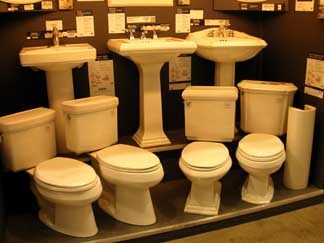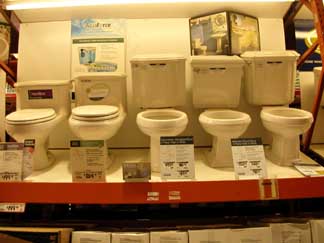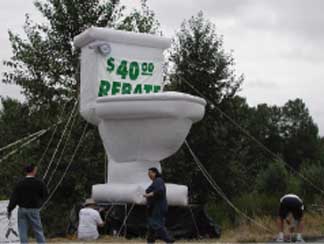You want to buy a new toilet and you want to make sure it works properly. You may have heard horror stories about new ultra low flush toilets that only use 1.6 gallons of water per flush. But fear not! There are many excellent toilets available that work well and use much less water than the inefficient models of yesteryear.
Why 1.6 gallons per flush?
Federal law currently mandates that all toilets manufactured in the U.S. must use an average of 1.6 gallons (6 liters) per flush or less. These 1.6 gallons per flush toilets are often referred to as ultra-low-flush or ULF toilets.
This law was put into place in 1992 in an effort to improve water efficiency nationwide and coordinate various state standards.
Toilets made from the early 1980s to 1992 used 3.5 gallons per flush or more. Toilets made prior to 1980 used 5.0 to 7.0 or high gallons per flush. The oldest toilets can use more than 8 gallons per flush. Replacing an old toilet with a new ULF model can result in substantial water savings.

Selecting a Toilet: Gravity vs. Pressure Assist
There are two basic types of toilets on the market for the residential sector – gravity flush and pressure assist models. Most toilets (old and new) utilize a gravity flush mechanism, but pressure assist models are becoming increasingly popular as manufacturers strive to improve flushing effectiveness while using 1.6 gallons of water or less.
Gravity
The most common type of toilets are the gravity-fed models which rely on the weight of the water and head pressure (height of the water in the tank) to promote the flush. If you see freestanding water when peering down into the tank, your toilet is gravity fed.
Some old-fashioned toilets had a tank mounted high on the wall above the bowl with a long chain for flushing. These old-time toilets used the height to increase the head pressure and resulting flushing action.
Gravity toilets depend on the volume of water in the tank to flush waste and usually require water pressure of no more than 10 – 15 pounds per square inch (psi) to operate properly. The tank and bowl are usually two separate pieces, although this is not obvious once they are in use.
A few one-piece toilets are also available. Gravity tank toilets are relatively inexpensive, with retail prices for two-piece toilets ranging from $75 – $200 and one-piece models costing somewhat more.
Pressure-Assist
The pressure-assisted toilet relies on air pressure within a cylindrical tank (metal or plastic-like material) inside your toilet tank. Air inside the cylinder forces a vigorous, rapid, and occasionally noisy flush.
The cylinder, along with the “roaring/whooshing” sound when you flush it, are sure signs of a pressure-assisted toilet. If you look inside the toilet tank of a pressure-assist model there should be no freestanding water visible. Pressure-assist toilets require a minimum water pressure of 25 psi to operate well. Retail prices for these toilets are generally over $150.
Purchasing Tips
Before you go shopping:
- Determine the type discharge drain line you have.
Floor-Discharge Drain Line: This toilet is usually bolted to the floor.
Wall-Discharge Drain Line: This toilet is usually attached to the wall, rather than the floor. They can be either gravity or flush valve type toilets. - Measure the distance from the wall behind the existing toilet to the middle of the toilet drain opening in the floor. Having this “rough-in” dimension will ensure that you purchase the correct size toilet.
- Anticipate possible additional work required. While some toilet replacement jobs will proceed as simple “drop-in” replacements, there are a number of small and large additional tasks that could arise.
These may include: Floor tile work, Fality shut-off valve repair, Repair or modification of water supply lines, Repair or modification of the drain line pitch, Repair or modification of the venting system. - Plan for the legal disposal of old toilets. Talk to your plumber about a plan to dispose of the old toilets. Most internal toilet parts can be removed and sold as recyclable scrap metal. Contact your local solid waste authority for information on their requirements for disposal.

At the store:
- Shop around for the right toilet. The cheapest toilet may not be the best. You want a toilet that does not clog easily, clears the bowl with a single flush and is largely self-cleaning.
- If the model you choose uses an early closure flapper, make sure that when the flapper wears out, you replace it with another early closure flapper.
- Make sure that the toilet’s flapper is made of the new materials that are resistant to tablet type bowl cleaners, better yet, don’t use caustic tablets in your toilet.
- Some toilets are offer a fully glazed trapway and some do not. A fully glazed trapway, while not a requirement for a good functioning toilet, can improve flushing and bowl cleaning performance. The quality of the pottery is often as important as the flushing mechanism.
- Ask about the diameter of the trap. They range from 1 1/2″ to 2 1/2″ diameter. Generally, the larger the trap the better the performance, larger than 2 1/4″ is preferred.
- The American National Standards Institute (ANSI) designs minimum performance tests and standards for low-consumption toilets. If you have any doubt about a model’s performance, ask to see the manufacturer’s performance testing data.
- Listen carefully to the noise level of the toilet models you are considering. Some are quieter than others.
- Ask about references. A good performance record is the single most important indicator of quality. Manufacturers have changed their models of low-consumption toilet models considerably since their introduction. Don’t be misled by reports of poor performance by old low-consumption toilet models that have been discontinued. Make your decisions based on current models.
- Some manufacturers may offer guarantees that their products will perform well or will not leak for many years. Also, before purchasing, ask about the seller’s return policy.
Water Conservation Tip
Some manufacturers are now offering dual flush toilets. These innovative products offer two flushing modes – a half-flush for liquid and a full-flush for solids. Dual flush models have been shown to use less water than standard ULF toilets.
Toilet Incentives or Rebates
Some water providers, cities, and utility companies offer financial incentives for replacing old inefficient toilets. Typically they offer a rebate of between $25 and $100 per toilet. In some cases they may offer free toilet replacement.
For information about toilet rebates and incentive programs in your area, contact your local water provider.
Toilet drives, such as the Bellevue Toilet Roundup pictured below, help to motivate community residents to replace their old inefficient toilets.

- If You Have No Hot Water Pressure, Here’s What You Should Do - December 28, 2021
- What is the Right Shower Drain Pipe Size? - January 25, 2020
- Wet Vent Plumbing, What Is It? How Do You Utilize It? - November 17, 2019
